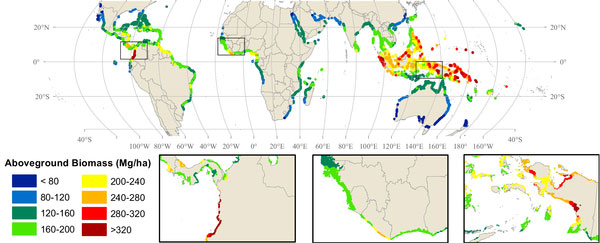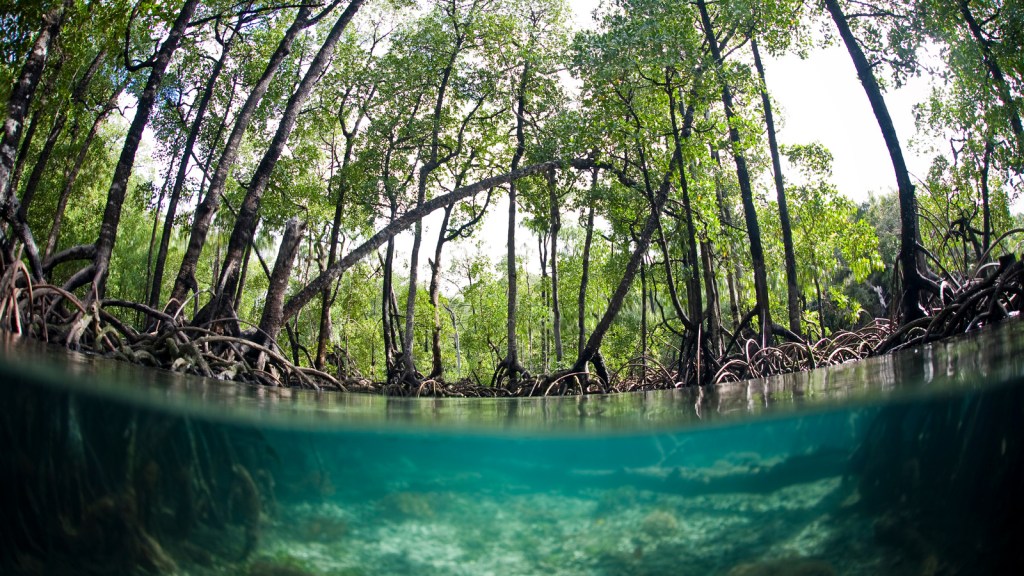My colleagues and I have just published a study in Conservation Letters in which we work out how much carbon there is in the world’s mangrove forests, give or take a bit.
And we mapped it.
And here’s why these findings are tremendously important:
They quantify what some of us in marine conservation have been saying for a decade or more: That mangrove forests are among the most carbon-rich habitats on the planet. That, although they occupy just a fraction of the world’s surface, they pack a punch.
Anyone concerned about preserving nature’s value — carbon sequestration and all the other benefits mangroves provide us — needs to think hard about this.
Because on average, mangroves have double the living biomass of tropical forests overall. This means that if you want to slow carbon emissions, one of the first places you could look would be in the mangroves. Stop an acre of loss here, and you will achieve a much bigger win than in many other areas.
But the average also hides a host of variance. Look at the map here and you’ll see that there’s a tenfold range in above-ground biomass:

So as we make our increasingly bold statements about the importance of mangrove biomass — or indeed around any ecosystem services — it is SO important that we have the numbers to back up our claims.
Until this paper, the best we could in most places was provide a global average number. “A typical mangrove has 152 tons of aboveground biomass per hectare,” we might say.
That doesn’t sound at all convincing whether you are standing at the foot of canopy giant in Berau, Indonesia, or indeed on the margins of straggly community of mangrove shrubs in the desert margins of the Middle East.
To do this new paper, we stood on the shoulders of hundreds of others who have sweated and toiled in the tropical heat of the mangroves, doing the real work of assessing biomass.
We took numbers from 95 studies around the world and built a computer model around the climatic factors that help to drive the variability in biomass from place to place.
It’s a model, of course, and only captures part of reality, but it’s a huge advance. We need this sort of work — both the hard data from the field scientists and the verifiable models of what’s going on.
It means so much more than average numbers. Without it, all our platitudes and pleadings about the value of nature run the risk of sounding hollow.
The map shows the real hotspots for mangrove biomass. The countries of the Coral Triangle lead the way, but the overlap with coral reefs isn’t always neat — it’s the wet muddy coasts of Sumatra, Borneo, and New Guinea that have the very high biomass.
So, too, does an extraordinary stretch of coastline in on the Pacific coast of Colombia and Northern Ecuador. In all these places mangroves are truly breathtaking — gigantic trees with canopies reaching well over 30m high. These are found on wide, still growing deltas where they hold together sediments and add vast amounts of organic nutrients to the soils and the surrounding waters.
When it comes to soils, we’re still struggling with the models a bit, but the story is equally compelling. Most mangrove forests lay down peat — thick, heavy layers of carbon-rich soil that stays waterlogged and doesn’t rot.
There are other important peat forests worldwide, but the microbial processes in those peat forests give off pretty substantial amounts of methane, which is a greenhouse gas in its own right. The saline soils of the mangroves generally prevent this methane production. That gives us a huge extra carbon store in the soil.
But it’s not just a store. Mangroves are celebrated as one of the most productive ecosystems on the planet, and it is believed that about 10% of what they produce also gets sequestered away in the soil.
That word “sequestered” should be music to our ears. In other words, mangroves are natural carbon-scrubbers, taking CO2 out of the atmosphere and packing it away, for millennia or more, in their rich soils.
So if you had a dollar to invest in carbon futures, my strongest advice of all would be to invest in preventing mangrove loss, or even restoration. There’s no magic cure to the challenges of global change – warming, rising seas, worsening storms and ocean acidification – we’ll only ever get there through a combination of interventions. Mangroves aren’t sufficiently widespread to tip the scales, but they give a greater return on investment than many other mitigation efforts.
But on a unit-area basis, it would be hard to think of a more important ecosystem. And that’s before you even start to add up the value for fisheries, timber, tourism, coastal protection and so on.
This work was supervised by Dr. Mark Spalding, the lead author was James Hutchison, a researcher at the University of Cambridge now working with TNC on mangrove fisheries, and the other co-authors were other Cambridge conservation scientists: Andrea Manica, Ruth Swetnam (now at University of Staffordshire) and Andrew Balmford.




Mangrove soil is a potential sink of carbon. Soil organic carbon, pH and salinity were monitored in mangrove ecosystem of Indian Sundarbans in five successive years (2006–2010) by Dr. Abhijit Mitra and his team. Samplings were carried out at 14 stations in four different depths (0.01-0.10, 0.10-0.20, 0.20-0.30 and 0.30-0.40 m) during premonsoon period. High organic carbon load is observed in the stations of western Indian Sundarbans (mean = 1.02 Wt %) which are near to the highly urbanized city of Kolkata. The central and eastern sectors under the protected forest area show comparatively less soil organic carbon (mean = 0.64 Wt %). A unique spatial variability in soil salinity and pH was observed with lower values in the western and eastern sectors compared to central sector. Soil pH exhibited a lower value (7.47 0.071) in reserve forest zone (central and eastern sectors) compared to western sector (7.57 0.067). The soil salinity increased with depth, while organic carbon and pH decreased with depth in all the stations. The paper depicts the increase of soil organic carbon and pH due to anthropogenic activities in western Indian Sundarbans, which if continued may decrease the potential of Sundarban soil as carbon sink and make the soil highly saline. Hence curbing of anthropogenic activities may keep the soil characteristics ecologically safe.
I need the literature about the mangrove carbon storage studies on aboveground biomass and understorey biomass like litter layer and herbaceous vegetation of biomass content.
I’d like to rad more about Mangroves, eco-system, education & benefits of preservation, & restoring. Area maps, graphs, that show locations in Florida.
Where are your citations? What articles were used for this blog? i really want to know what research was used for this.
There is a link to the paper in Conservation Letters at the beginning of the blog. You can read the original paper here: https://onlinelibrary.wiley.com/doi/full/10.1111/conl.12060
Thanks!